
John Harwood
ACTIVE IN LONDON 1818 - 1828
THE SNOW THAMES IN TWO POSITIONS OFF HARWICH
oil on canvas
76.2 by 106.7 cm.; 30 by 42 in.

Thomas Luny
ST. EWE, CORNWALL 1759 - 1837 LONDON
PORTSMOUTH FROM SPITHEAD
Oil on canvas
each: 38.7 by 51.4 cm.; 15 1/4 by 20 1/4 in.

Thomas Luny
ST. EWE, CORNWALL 1759 - 1837 LONDON
THE ENTRANCE TO CORK HARBOUR
Oil on canvas
each: 38.7 by 51.4 cm.; 15 1/4 by 20 1/4 in.

Attributed to Richard Wright of Liverpool
LIVERPOOL 1735 - CIRCA 1774
BRITISH MEN O' WAR IN AN ESTUARY
oil on canvas
90.8 by 148.3 cm.; 35 3/4 by 58 3/8 in.

Attributed to Andries van Eertvelt
ANTWERP 1590 - 1652
MARINE BATTLE BETWEEN TURKS AND CHRISTIANS
oil on canvas, unlined
124.5 by 131.2 cm.; 49 by 91 in.

Willem van de Velde the Younger
LEIDEN 1633 - 1707 LONDON
SEASCAPE WITH PASSING STORM
oil on canvas
35.5 by 62 cm.; 14 by 23 7/8 in
![Derek George Montague Gardner (British, 1914-2007) Nelson's Santa Cruz Squadron 15 x 20 in. (38.1 x 50.8 cm.), sight. [not examined out of the frame]](http://images2.bonhams.com/image?src=Images/live/2014-11/26/9093092-19-1.jpg&width=640&height=480&autosizefit=1)
Derek George Montague Gardner (British, 1914-2007)
Nelson's Santa Cruz Squadron
signed and dated: "Derek G.M. Gardner/1984"
watercolor on paper
15 x 20 in. (38.1 x 50.8 cm.)
Derek George Montague Gardner (13 February 1914 – 11 February 2007) is best known as an English painter. After a career as a civil engineer before and after serving in the Royal Navy in the Second World War, he became widely recognised as one of the leading English painters of marine subjects.
He was educated at Oundle School, where he won a prize for his drawing. He left school in 1931, and trained as a civil engineer in Glasgow with the London Midland & Scottish Railway. He later joined Sir William Arrol & Co. He joined the RNVR as a 20-year-old midshipman, and took up painting watercolours of warships. He became a docks engineer at North Shields in 1938. More
![Derek George Montague Gardner (British, 1914-2007) Frigates in Torbay, September 1794 8-3/4 x 13 in. (22.2 x 33 cm.), sight. [not examined out of the frame]](http://images2.bonhams.com/image?src=Images/live/2014-12/04/9093092-29-2.jpg&width=640&height=480&autosizefit=1)
Derek George Montague Gardner (British, 1914-2007)
Frigates in Torbay, September 1794
signed lower right: "Derek G.M. Gardner"
Watercolor on paper
8-3/4 x 13 in. (22.2 x 33 cm.)
Torquay is a seaside town in Devon, England, part of the unitary authority area of Torbay. The town's economy was initially based upon fishing and agriculture, but in the early 19th century the town began to develop into a fashionable seaside resort, initially frequented by members of the Royal Navy during the Napoleonic Wars while the Royal Navy anchored in the bay. Later, as the town's fame spread, it was popular with the crème de la crème of Victorian society. Renowned for its healthful climate, the town earned the nickname of the English Riviera. More
![Derek George Montague Gardner (British, 1914-2007) The H.M.S. Suberb 9-1/2 x 13-3/4 in. (24.1 x 34.9 cm.), sight. [not examined out of the frame]](http://images2.bonhams.com/image?src=Images/live/2014-12/04/9093092-33-2.jpg&width=640&height=480&autosizefit=1)
Derek George Montague Gardner (British, 1914-2007)
The H.M.S. Suberb
signed lower left: "Derek G.M. Gardiner"
watercolor on paper
9-1/2 x 13-3/4 in. (24.1 x 34.9 cm.
![Derek George Montague Gardner (British, 1914-2007) H.M.S. Russell at anchor in Torbay 7-3/4 x 10 in. (19.6 x 25.4 cm.), sight. [not examined out of the frame]](http://images2.bonhams.com/image?src=Images/live/2014-12/05/9093092-39-1.jpg&width=640&height=480&autosizefit=1)
Derek George Montague Gardner (British, 1914-2007)
H.M.S. Russell at anchor in Torbay
signed and dated lower right: "Derek G.M. Gardner/ 1989"
watercolor on paper
7-3/4 x 10 in. (19.6 x 25.4 cm.), sight.
On 12 February 1808 Russell arrived off the Danish possession of Tranquebar where she landed troops of the 14th Regiment of Foot and the Honourable East India Company's artillery. The British immediately went on to capture the settlement, which capitulated without resistance.
On 16 October 1803 she was three days out of Rio and in company with the fourth rate HMS Grampus. They were escorting the East Indiamen Northampton, Lord Melville, Earl Spencer, Princess Mary, Anna, Ann, Glory, and Essex, all bound to Bengal.
She was sold out of the service in 1811. More
![Derek George Montague Gardner (British, 1914-2007) The H.M.S. Royal Sovereign off of Fort Manoel, Valletta, Malta 13-1/2 x 20 in. (34.2 x 50.8 cm.), sight. [not examined out of the frame]](http://images2.bonhams.com/image?src=Images/live/2014-12/04/9093092-27-2.jpg&width=640&height=480&autosizefit=1)
H.M.S. Royal Sovereign was a 100-gun first rate ship of the line of the Royal Navy, which served as the flagship of Admiral Collingwood at the Battle of Trafalgar. She was the third of seven Royal Navy ships to bear the name. Designed by Sir Edward Hunt, she was launched at Plymouth Dockyard on 11 September 1786. She was known by her crew as the "West Country Wagon" due to her poor manoeuvrability and speed.
![Derek George Montague Gardner (British, 1914-2007) The H.M.S. Royal Sovereign off of Fort Manoel, Valletta, Malta 13-1/2 x 20 in. (34.2 x 50.8 cm.), sight. [not examined out of the frame]](http://images2.bonhams.com/image?src=Images/live/2014-12/04/9093092-27-2.jpg&width=640&height=480&autosizefit=1)
Derek George Montague Gardner (British, 1914-2007)
The H.M.S. Royal Sovereign off of Fort Manoel, Valletta, Malta
signed lower left: "Derek G.M. Gardner"
watercolor on paper
13-1/2 x 20 in. (34.2 x 50.8 cm.),
The first ship of the fleet in action at Trafalgar on 21 October 1805, she led one column of warships; Nelson's Victory led the other. She pulled well ahead of the rest of the fleet. As she cut the enemy line alone and engaged the Spanish three decker Santa Ana.
Royal Sovereign and Santa Ana duelled for much of the battle, with Santa Ana taking fire from fresh British ships passing through the line, while nearby French and Spanish vessels fired on Royal Sovereign. Santa Ana struck at 14:15. Shortly afterwards a boat came from Victory carrying Lieutenant Hill, who reported to Admiral Collingwood that Nelson had been wounded.
Realising that he might have to take command of the rest of the fleet and with his ship being "perfectly unmanageable", he signalled for the frigate Euryalus to take Royal Sovereign in tow. Euryalus towed her round to support the rest of the British ships with her port-side guns. Fire from the lead ships shot away the cable between the Royal Sovereign and the Euryalus, and the latter ship made off towards Victory. Royal Sovereign exchanged fire with the arriving ships, until Collingwood rallied several relatively undamaged British ships around Royal Sovereign.
Victory 's boats came alongside and reported Nelson's death. This left Collingwood in command of the fleet, and with a storm rising. Collingwood had to transfer himself and his flag to the frigate Euryalus. Euryalus sent a cable across and took Royal Sovereign in tow for second time.
After her useful active life she was converted to harbour service as a receiving ship at Plymouth before being renamed HMS Captain. Hulked in June 1826. Four of her guns were saved and are incorporated in the Collingwood Memorial in Tynemouth. More
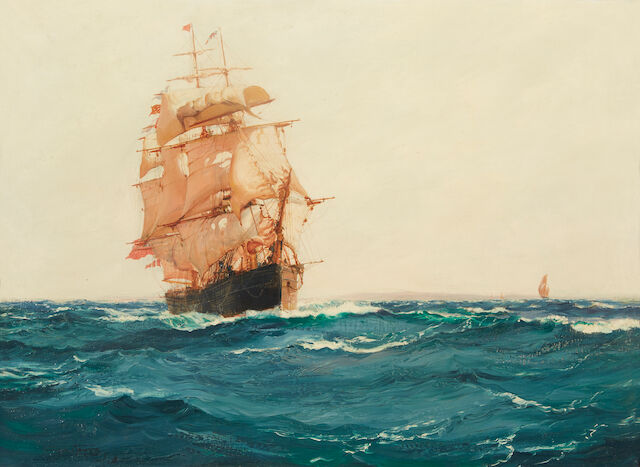
Montague Dawson (British, 1890-1973)
Up Channel - The Red Jacket
signed lower left "Montague Dawson"
oil on canvas
22 x 30 in. (55.8 x 76.2 cm.)
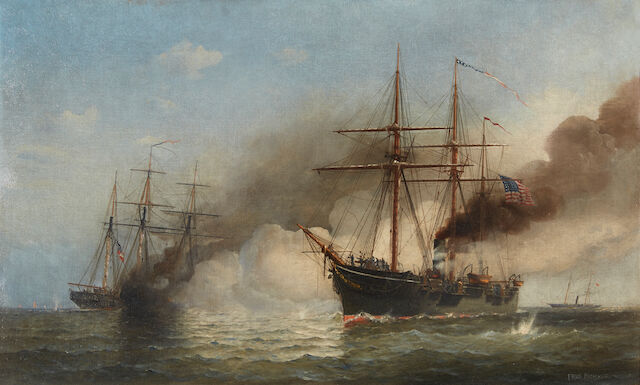
Fred Pansing (American, 1844-1912)
The Battle of Cherbourg, June 19th 1864
depicting the battle between the C.S.S. Alabama and the U.S.S. Kearsarge off the coast of France.
signed lower right: "Fred Pansing"
oil on canvas
22 x 36 in. (55.8 x 91.4 cm.)
The Alabama had been pursued for two years by the sloop-of-war USS Kearsarge, under Captain John Winslow. From Cádiz in November of 1862 until March 1863 Kearsarge prepared for her engagement with Alabama; she searched for the raider along the coast of Northern Europe all the way to the Canaries, Madeira, and the Outer Hebrides.
On 14 June 1864, Kearsarge arrived at Cherbourg and found Alabama in port; the raider had returned there for much needed repairs after a very long, multiple ocean cruise at the expense of 65 Union merchant ships.
Kearsarge took up station at the harbor's entrance to await Semmes' next move. Kearsarge did not attack, as the Alabama was in a neutral port; instead, she waited, initiating a blockade of CSS Alabama in Cherbourg. On June 19, C.S.S. Alabama, ran up the "Stars and Bars" and exited the harbor to attack Kearsarge. The Alabama was escorted by the French ironclad Couronne, whose mission was to ensure that the ensuing battle occurred outside the French harbor.
Once out, Kearsarge turned about again, hoisted the United States Navy Jack, and lined up for a broadside. The two warships maneuvered on opposite courses throughout the battle. Kearsarge. On the French coast, hundreds watched the battle. Kearsarge 's armor cladding sustained two hits during the engagement with only minor damage. The gunnery of U.S.S. Kearsarge was more accurate than that of the Confederates; she fired slowly with well-aimed shots, while Alabama fired rapidly, firing over 300 rounds during the course of the battle.
Eventually, after just over an hour of exchanging artillery fire, Alabama had received shot-holes beneath the waterline from Kearsarge 's Dahlgren guns and began to sink. Captain Semmes struck the Confederate colors, but still the Kearsarge continued firing until a white flag was seen, raised by one of the rebel sailors with his hand.
Thirty or so were rescued by the Deerhound, a British yacht, which Captain Winslow asked to help evacuate Alabama 's crew. Captain Semmes and fourteen of his officers were among the sailors rescued by Deerhound. Instead of delivering the captured rebels to Kearsarge, the Deerhound set a course for Southampton, thus enabling Captain Semmes' escape. More
Fred Pansing (1844-1912) was born in Bremen, Germany, Pansing became a sailor at age 16. After five years at sea, he settled in Hoboken, New Jersey establishing himself as a marine painter and portraitist in 1865. With excellent draftsmanship he also worked in New York City and Brooklyn as an artist illustrating sheet music and painting names on steamboats.
In the late 1890's, Pansing worked for American Lithography in Jersey city. On the side he created oil paintings which have been celebrated for their "luminous color and finely detailed lines", attributes which were easily translated into this printed medium, typically published as chromolithographs.
He is best known for painting steamships for prestigious ocean lines with regular commissions from Cunard and White Star Lines. They were seen as sailing posters, promotional materials aboard ships and in ticket offices. More
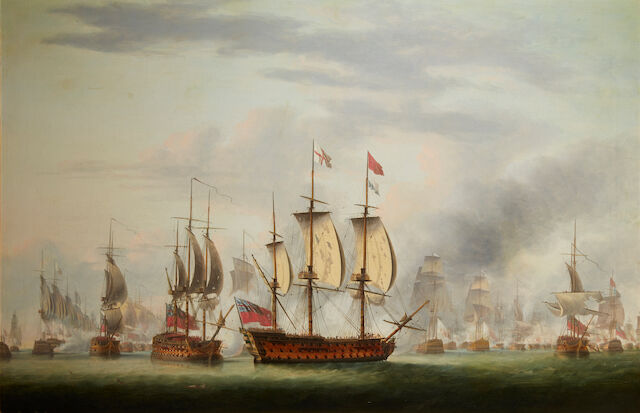
Fred Pansing (1844-1912) was born in Bremen, Germany, Pansing became a sailor at age 16. After five years at sea, he settled in Hoboken, New Jersey establishing himself as a marine painter and portraitist in 1865. With excellent draftsmanship he also worked in New York City and Brooklyn as an artist illustrating sheet music and painting names on steamboats.
In the late 1890's, Pansing worked for American Lithography in Jersey city. On the side he created oil paintings which have been celebrated for their "luminous color and finely detailed lines", attributes which were easily translated into this printed medium, typically published as chromolithographs.
He is best known for painting steamships for prestigious ocean lines with regular commissions from Cunard and White Star Lines. They were seen as sailing posters, promotional materials aboard ships and in ticket offices. More

Robert Dodd (British, 1748-1816)
The Battle of the Saints
Admiral Lord George Brydges Rodney flagship, H.M.S. Formidable is depicted at the center.
oil on canvas
32-1/2 x 42-1/2 in.
Robert Dodd (1748–1815) was a British marine painter and aquatint engraver. He is known for his works on the French Revolutionary Wars. Living in Wapping, London, he had plenty of material to hand in the way of ships, docks and wharfs, and much of his work includes scenes of the River Thames and naval dockyards. Other themes include battles and actions of the French Revolutionary Wars and the American War of Independence. Much of his work was subsequently engraved by other artists. His use of light effects, particularly the contrasts between the sun's rays and the dark clouds, or the fire against the smoke of battle, convey the drama and activity of a sea battle. Although technically accurate and meticulous, his artistic talents were somewhat eclipsed by the greatest of his peers, and it is his contribution to the historical record that is his greatest legacy. More on Robert Dodd
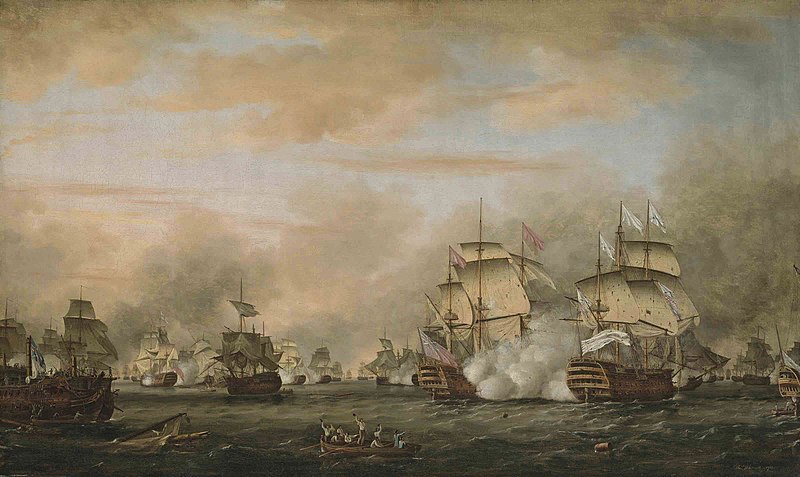
Thomas Whitcombe (London c. 1752-1824)
The Battle of the Saintes, 9-12 April 1782
signed and dated 'Tho,s Whitcombe-1783.' (lower right)
oil on canvas
35 x 59½ in. (89 x 151.1 cm.)
The Battle of the Saints was an important naval battle that took place over 4 days, from April 9–12 1782, during the American Revolutionary War, and was a victory for the British fleet under Admiral Sir George Rodney over a French fleet under the command of Comte de Grasse forcing the French and Spanish to abandon a planned invasion of Jamaica. The battle is named after the Saintes (or Saints), a group of islands between Guadeloupe and Dominica in the West Indies. The French fleet defeated here was the same fleet that had blockaded the British Army during the Siege of Yorktown. The French suffered heavy casualties and many were taken prisoner including the Comte de Grasse. More on The Battle of the Saints
Robert Dodd (1748–1815) was a British marine painter and aquatint engraver. He is known for his works on the French Revolutionary Wars.
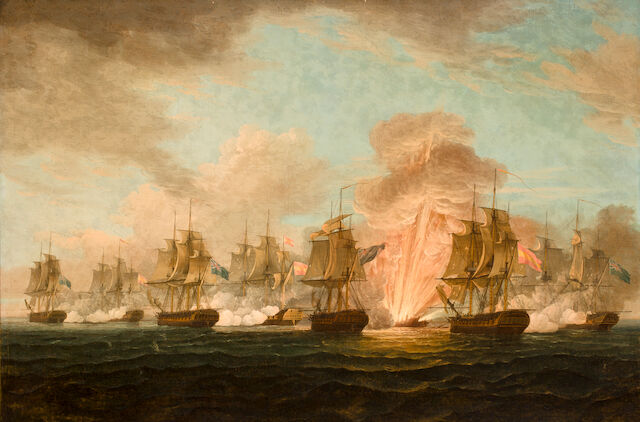
The Battle of Cape Santa Maria took place off the southern Portuguese coast, in which a British squadron under the command of Commodore Graham Moore attacked a Spanish squadron commanded by Brigadier Don José de Bustamante y Guerra, without declaration of war between the Britain and Spain.
Under the terms of a secret convention Spain had to pay 72 million francs annually to France, until it declared war on Britain. The British had learned of the treaty, and knew it was likely that Spain would declare war soon. Bustamante set sail from Montevideo on 9 August 1804 with four frigates loaded with gold and silver, as well as other valuable cargo. On 22 September Vice Admiral Lord Collingwood ordered Captain Graham Moore, commanding the 44-gun frigate HMS Indefatigable, to intercept and detain the Spanish ships, peacefully, if possible.
At dawn on 5 October, the Spanish frigates were sighted off the coast of Portugal. At 7 a.m. they sighted the four British frigates. Bustamante ordered his ships into line of battle, and within an hour the British came up in line, to windward of the Spaniards. Commodore Moore, sent Lieutenant Ascott to the Spanish flagship Medea, to explain his orders. Bustamante naturally refused to surrender. Commodore Moore ordered a shot be fired ahead over the bow of Medea. Almost immediately a general exchange of fire broke out. Within ten minutes the magazine of the Mercedes exploded destroying the ship (the moment depicted in this painting), and killing all but 40 of her 240 crew. Within half an hour the Santa Clara and the Medea had surrendered, and the Fama broke away trying to flee, the H.M.S. Medusa quickly followed. However, Moore ordered the faster H.M.S. Lively to pursue, capturing the Fama a few hours later. Spain declared war on Great Britain on 14 December 1804, only to suffer a catastrophic defeat less than a year later at the Battle of Trafalgar in October 1805. More

Thomas Moran (February 12, 1837 – August 25, 1926) from Bolton, England was an American painter and printmaker of the Hudson River School in New York whose work often featured the Rocky Mountains. Moran and his family took residence in New York where he obtained work as an artist. He was a younger brother of the noted marine artist Edward Moran, with whom he shared a studio. A talented illustrator and exquisite colorist, Thomas Moran was hired as an illustrator at Scribner's Monthly. During the late 1860s, he was appointed the chief illustrator for the magazine, a position that helped him launch his career as one of the premier painters of the American landscape.
Moran along with Albert Bierstadt, Thomas Hill, and William Keith are sometimes referred to as belonging to the Rocky Mountain School of landscape painters because of all of the Western landscapes made by this group. More
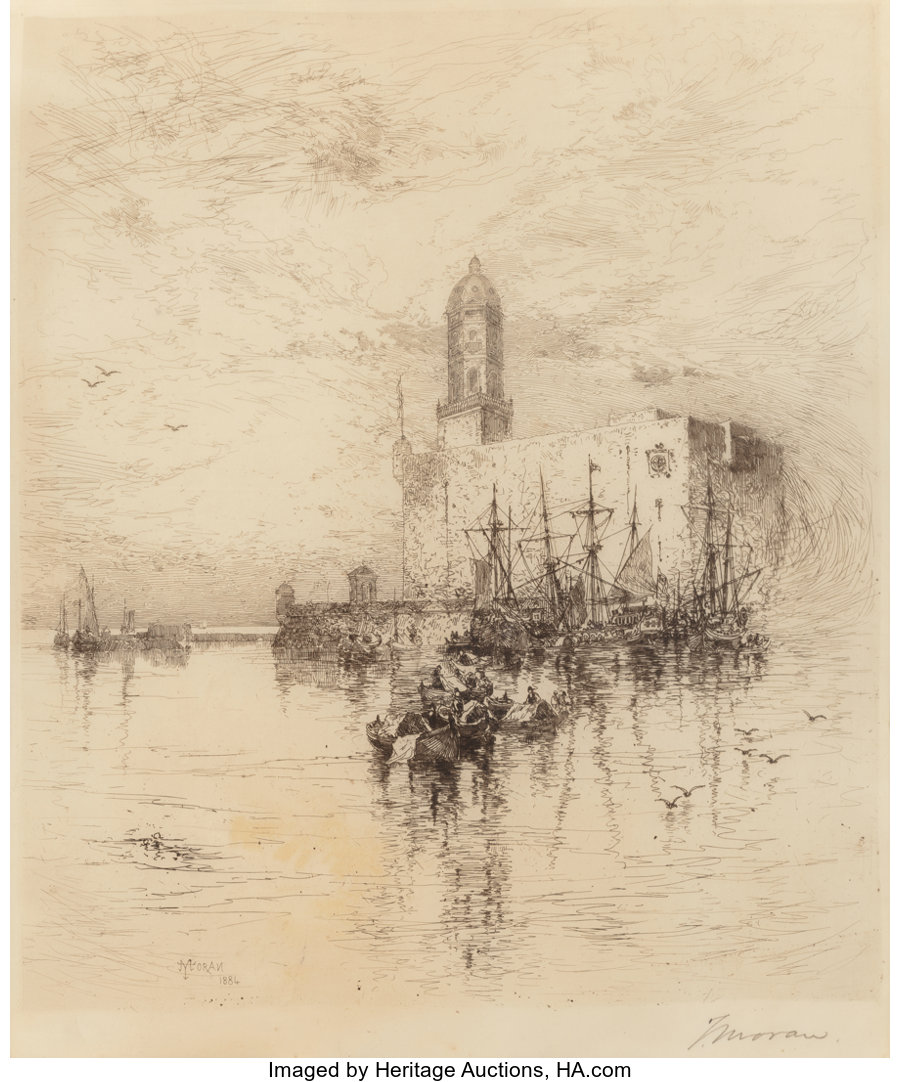
Thomas Whitcombe (possibly 19 May 1763 – c. 1824) was a prominent British maritime painter of the Napoleonic Wars. Among his work are over 150 actions of the Royal Navy, and he exhibited at the Royal Academy, the British Institution and the Royal Society of British Artists. His pictures are highly sought after today.
Whitcombe was born in London between 1752 and 19 May 1763. Little is known of his background or training.
It is known that he was in Bristol in 1787 and later travelled to the South Coast; there are few ports or harbours from this region that do not feature in his work. In 1789 he toured Wales and in 1813 he travelled to Devon, painting scenes around Plymouth harbour. During his career he also painted scenes showing the Cape of Good Hope, Madeira, Cuba and Cape Horn. Between 1783 and 1824 he lived in London, including addresses in Covent Garden and Somers Town during the course of his exhibiting career.
His date of death, like that of his birth is uncertain; it was not before 1824, and possibly as late as 1834. More on Thomas Whitcombe

Thomas Whitcombe (British, 1760-1824)
The Battle of Cape Santa Maria
the H.M.S. Indefatigable and her consorts H.M.S. Lively, H.M.S. Medusa and H.M.S. Amphion capturing the Spanish squadron and their treasure off Cape Santa Maria on October 5th 1804.
oil on canvas
36-1/2 x 55 in. (92.7 x 139.7 cm.)
Under the terms of a secret convention Spain had to pay 72 million francs annually to France, until it declared war on Britain. The British had learned of the treaty, and knew it was likely that Spain would declare war soon. Bustamante set sail from Montevideo on 9 August 1804 with four frigates loaded with gold and silver, as well as other valuable cargo. On 22 September Vice Admiral Lord Collingwood ordered Captain Graham Moore, commanding the 44-gun frigate HMS Indefatigable, to intercept and detain the Spanish ships, peacefully, if possible.
At dawn on 5 October, the Spanish frigates were sighted off the coast of Portugal. At 7 a.m. they sighted the four British frigates. Bustamante ordered his ships into line of battle, and within an hour the British came up in line, to windward of the Spaniards. Commodore Moore, sent Lieutenant Ascott to the Spanish flagship Medea, to explain his orders. Bustamante naturally refused to surrender. Commodore Moore ordered a shot be fired ahead over the bow of Medea. Almost immediately a general exchange of fire broke out. Within ten minutes the magazine of the Mercedes exploded destroying the ship (the moment depicted in this painting), and killing all but 40 of her 240 crew. Within half an hour the Santa Clara and the Medea had surrendered, and the Fama broke away trying to flee, the H.M.S. Medusa quickly followed. However, Moore ordered the faster H.M.S. Lively to pursue, capturing the Fama a few hours later. Spain declared war on Great Britain on 14 December 1804, only to suffer a catastrophic defeat less than a year later at the Battle of Trafalgar in October 1805. More
Thomas Sidney Moran (American, Late 19th Century)
Sailing Ship on the High Seas, 1904
Watercolor on paper
14-1/4 x 10-1/4 inches (36.2 x 26.0 cm)
Signed lower left and lower right: TSMoran; 4/TSMoran
Moran along with Albert Bierstadt, Thomas Hill, and William Keith are sometimes referred to as belonging to the Rocky Mountain School of landscape painters because of all of the Western landscapes made by this group. More
Thomas Sidney Moran (American, Late 19th Century)
Vera Cruz Harbor, Mexico, 1884
Etching
11-1/4 x 9-5/8 inches (28.6 x 24.4 cm)
Signed in pencil in lower margin: TMoran
![Luca Papaluca (Italian, 1890-1934) The American steam yacht Sumar of the New York Yacht Club 16 x 26 in. (40.6 x 66 cm.) [not examined out of the frame]](http://images2.bonhams.com/image?src=Images/live/2014-11/25/9091901-1-1.jpg&width=640&height=480&autosizefit=1)
Luca Papaluca (Italian, 1890-1934)
The American steam yacht Sumar of the New York Yacht Club
inscribed at the center "-Sumar.N.Y.Y.C.-"
signed lower right: "L. Papaluca"
watercolor, pastel, and gouache on paper
16 x 26 in. (40.6 x 66 cm.)
![Luca Papaluca (Italian, 1890-1934) The American steam yacht Sumar of the New York Yacht Club 16 x 26 in. (40.6 x 66 cm.) [not examined out of the frame]](http://images2.bonhams.com/image?src=Images/live/2014-11/25/9091901-1-1.jpg&width=640&height=480&autosizefit=1)
Luca Papaluca (Italian, 1890-1934)
The American steam yacht Sumar of the New York Yacht Club
inscribed at the center "-Sumar.N.Y.Y.C.-"
signed lower right: "L. Papaluca"
watercolor, pastel, and gouache on paper
16 x 26 in. (40.6 x 66 cm.)
to 89
Acknowledgment: Bonhams,





























